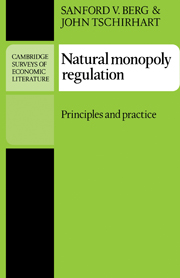Book contents
- Frontmatter
- Contents
- Preface
- 1 Introduction to regulatory economics
- Part I Optimal pricing and investment for natural monopolies
- 2 Natural monopoly and the justification for regulation
- 3 Efficient pricing using linear prices
- 4 Efficient pricing using nonlinear prices
- 5 Peak-load pricing
- 6 Pricing and capacity under stochastic demand
- 7 Sustainability of natural monopolies
- Part II Natural monopoly regulation in practice
- References
- Author index
- Subject index
5 - Peak-load pricing
Published online by Cambridge University Press: 06 November 2009
- Frontmatter
- Contents
- Preface
- 1 Introduction to regulatory economics
- Part I Optimal pricing and investment for natural monopolies
- 2 Natural monopoly and the justification for regulation
- 3 Efficient pricing using linear prices
- 4 Efficient pricing using nonlinear prices
- 5 Peak-load pricing
- 6 Pricing and capacity under stochastic demand
- 7 Sustainability of natural monopolies
- Part II Natural monopoly regulation in practice
- References
- Author index
- Subject index
Summary
Goods produced by natural monopolies often have two characteristics that further complicate optimum pricing strategies: (1) cyclic demand and (2) nonstorability. Cyclic demand is typical of goods such as roadways and entertainment facilities, as well as public utility goods such as electricity, natural gas, water, and telephone service. For example, at a given price, the quantity of electricity demanded depends on the season, on whether it is day or night, and on the time of day or night. The demand pattern tends to be cyclic in that winter demand always exceeds summer demand in colder climates, whereas the reverse is true in warmer climates, where daytime demand exceeds nighttime demand, late afternoon demand often exceeds early morning demand, and so on.
Of course, many other goods experience cyclic demand. The demand for ice skates is high in winter and low in summer, whereas the reverse holds for swimsuits. But these goods do not possess the second property of nonstorability; therefore, production levels can be uniform year-round, with in-season sales matched by inventories accumulated during the off season. This pattern of production is not possible with electricity and the other goods cited earlier. Electricity is produced when it is demanded; inventories are impossible or impractical in most instances because of the high cost of storage.
The dilemma, then, is this: Should the firm acquire adequate capacity to meet peak-period demands, thereby being burdened with significant excess capacity during off-peak periods, or should the firm acquire only enough capacity to meet off-peak demands, thereby allowing a significant portion of peak demand to go unsatisfied? We shall see that the answer is crucially linked to the marginal-cost pricing rules already developed.
- Type
- Chapter
- Information
- Natural Monopoly RegulationPrinciples and Practice, pp. 153 - 192Publisher: Cambridge University PressPrint publication year: 1989



